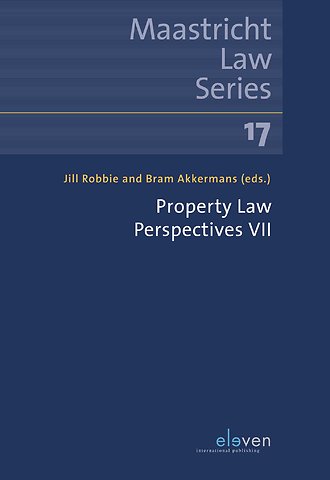



Bram Akkermans is Assistant Professor European Private Law and Associate-Director of the Maastricht European Private Law Institute (M-EPLI), Maastricht University.
Meer over de auteursProperty Law Perspectives VII
Samenvatting
This volume is the seventh instalment in the Property Law Perspectives Series. Produced by the Young Property Lawyers’ Forum (www.yplf.net), a global network of young property law scholars, this volume presents the carefully curated highlights of two consecutive conferences held at the University of Maastricht and the University of Glasgow.
A broad range of property law topics are covered in this book within the three themes of ‘Objects of Property Rights’, ‘Property and Justice’, and ‘Property and Land’. The chapters have been submitted by talented young researchers from jurisdictions around the world including Serbia, Chile, and South Africa, with each chapter providing an interesting analysis of an important aspect of property law.
This book merits the attention of every student and academic interested in new developments in property scholarship, as well as of legal practitioners looking to place societal developments into a legal context.
Trefwoorden
Specificaties
Inhoudsopgave
Part I Objects of Property Rights
1 How Do Tokens Fit In? Analysis of Switzerland’s Legislative Approach with a Focus on Property Law Aspects 3
Alexandra Dal Molin-Kränzlin
1 Introduction 3
2 To Regulate or not to Regulate? 5
2.1 International Developments 5
2.2 Switzerland’s Approach 6
3 Jungle of Terms – an Attempt to Shed some Light 8
4 Legal Qualification de lege lata 10
4.1 General Framework of the Swiss Civil Legal System 10
4.2 Are Utility Tokens and Asset Tokens Legal Objects? 11
4.2.1 Movable Physical Objects 11
4.2.2 Negotiable Securities 12
4.2.3 Uncertificated Securities 15
4.2.4 Intermediated Securities 16
4.3 Interim Conclusion 16
5 Proposed Amendments de lege ferenda 17
5.1 The Federal Council’s Pre-draft 17
5.1.1 General Remarks 17
5.1.2 Uncertificated Securities with Security Character in particular 18
5.2 Results of the Consultation Process 21
5.3 The Federal Council’s Draft 23
5.3.1 General Remarks 23
5.3.2 Ledger-based Securities 23
5.4 Analysis and Synthesis 26
6 Concluding Remarks 27
2 Virtual Things, Virtual Possessio, and Possessory Protection Thereof 29
Aleksa Radonjić
1 Introduction 29
2 Virtual Things 30
3 Possessio and Virtual Things 37
4 Conclusion 41
3 Property Over Incorporeal Goods: The Cornerstone of the Chilean Neoliberal Constitution 43
Viviana Ponce de León Solís
1 Introduction 43
2 Historical Background – Creating a New Playing Field 44
3 Incorporeal Goods and Incorporeal Things – Dialogues between the Constitution and the Civil Code 46
4 Vulgarisation of Property and Propertisation of Rights – Expanding and Reinforcing the Scope of the Property Clause 48
5 Conceptual Severance and the Regulatory Takings Doctrine – The Omnipresent Realm of Expropriations 51
6 Privatisation (without Expropriation) of Common Goods – The Case of Mine and Water Rights 56
7 Conclusions 61
Part II Property and Justice
4 The Vexed Question of Customary Law ‘Ownership’ of Sacred Waters – A Real Or Imagined Dispute Post Constitutionalism? 65
Mpho Bapela and Lesetja Monyamane
1 Introduction 65
2 The Common Law Notion of Ownership 67
2.1 Scope of Ownership 67
2.2 Content of Ownership 68
2.3 Limitation on Ownership 69
3 African Law Rights and Obligations in Land 70
3.1 Locating African Law in the South African Legal Milieu 70
3.2 Property Law Rights and Obligations in Land 72
4 Sacred Waters 76
4.1 Definition and Content 76
4.2 Ownership of Sacred Waters 77
4.2.1 The National Water Act 78
4.2.2 Water Services Act 79
5 Towards Existentialism 80
6 Conclusion 84
5 Property Restrictions in the Public Interest in Light of the Equality of Citizens Before Public Burdens 87
Samuel De Winter
1 Introduction 87
2 Property Restrictions in the Public Interest as a Rule not Compensable… 88
2.1 … Unless Compensation is Provided by Statutory Law 88
2.2 … Unless Compensation is Required to Restore Equality Amongst Citizens Before Public Burdens 89
2.2.1 The Equality of Citizens Before Public Burdens is on the Rise… 89
2.2.2 … But Also Comes as a Surprise in Belgium 90
2.2.3 Equality of Citizens Before Public Burdens: a General Principle of French and Belgian Law 91
2.2.4 A Principle with Constitutional Value 92
2.2.5 A Principle Applicable Independently of Statutory Law 92
2.2.6 A Principle to be Applied by Judges, Taking All Circumstances of the Case Into Account… 94
2.2.7 …With ParticularAttention toCitizens’ Expectations Regarding Societal Solidarity… 95
2.2.8 … to be Considered Using Standards of Reasonableness and Fairness… 96
2.2.9 … and Perhaps not only to be Considered by Judges but also by Public Authorities Themselves 97
2.2.10 Inequality Before Public Burdens Requires The Plaintiff to be Compared to Similar Others 98
2.2.11 Inequality Before Public Burdens: Less‘Faultless’ than it May Seem 99
3 Conclusion 100
6 Innovations in Land Registration and Their Impact on Cross-Border Conveyancing in Europe 103
Maria Kaczorowska
1 Introduction 103
2 An Overview of Land Registration Models 105
2.1 Criteria of Differentiation 105
2.2 Typologies of Land Registers 109
3 Informatisation of Land Registers 111
3.1 General Tendencies 111
3.1.1 Land Registers as Electronic Databases 112
3.1.2 Integration of Land Registry Data and Cadastral Data 112
3.1.3 Access to Electronic Land Registers 113
3.1.4 Implementation of New Technologies in Land Registration Proceedings 114
3.1.5 Development of E-Conveyancing 115
3.1.6 The Use of Blockchain Technology in Land Registration 115
3.2 Effects 117
4 Towards Harmonisation of Land Registers? 118
4.1 European Union Legal Framework 119
4.2 Practical Difficulties in Cross-Border Conveyancing 121
4.3 Integration and Cooperation Initiatives 121
4.3.1 European Land Information Service 122
4.3.2 European Land Registry Association and its Projects 123
5 Prospects and Challenges 125
6 Conclusion 128
Part III Property and Land
7 Good Old Feudal Times – A Toolbox for the (Re)Introduction of Land Burdens 133
Siel Demeyere
1 Introduction 133
2 The Concept of Land Burdens 136
3 Arguments Against and in Favour of More Land Burdens 137
3.1 Land Burdens and the Numerus Clausus Principle 138
3.2 Arguments Against More Land Burdens 139
3.3 Arguments in Favour of More Land Burdens 143
4 The Toolbox 145
4.1 Duration 145
4.2 Content 148
4.3 Creditor of the Burden 151
4.4 Publicity 151
4.5 Monetary Incentives 152
5 Conclusion 153
8 ‘Accidental’ Environmental Property Law in Belgium, France and Germany – The Prohibition of Excessive Nuisances (Neighbourhood Disturbances) as Protection for the Environment 155
Johan Van de Voorde
1 Introduction 155
2 The Historical Role of Nuisance Law as Environmental Law 159
3 Conditions for Nuisance Liability 159
4 Nuisance Liability as (Partially) Effective Weapon Against Pollution 160
4.1 Theoretical Analysis 160
4.2 Analysis of Case Law 161
4.3 General Criteria 164
5 Limits on the Effectiveness of Nuisance liability 165
5.1 Nuisance Liability is Meant to Legitimise Some Nuisances 165
5.2 Reductions of the Excessive Character 168
5.3 Effects of Environmental Regulations on Private Nuisance Law 169
5.4 Other Limits 171
6 Remedies – The Law and Economics of Nuisance Law as Protector of the Environment 172
6.1 Kinds of Remedies 172
6.2 ALawand EconomicsAnalysis of Financial Compensation for Nuisance 173
7 Conclusion 175
Anderen die dit e-book kochten, kochten ook
Net verschenen
Rubrieken
- aanbestedingsrecht
- aansprakelijkheids- en verzekeringsrecht
- accountancy
- algemeen juridisch
- arbeidsrecht
- bank- en effectenrecht
- bestuursrecht
- bouwrecht
- burgerlijk recht en procesrecht
- europees-internationaal recht
- fiscaal recht
- gezondheidsrecht
- insolventierecht
- intellectuele eigendom en ict-recht
- management
- mens en maatschappij
- milieu- en omgevingsrecht
- notarieel recht
- ondernemingsrecht
- pensioenrecht
- personen- en familierecht
- sociale zekerheidsrecht
- staatsrecht
- strafrecht en criminologie
- vastgoed- en huurrecht
- vreemdelingenrecht





